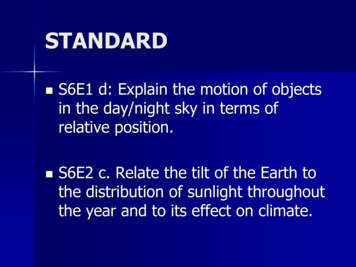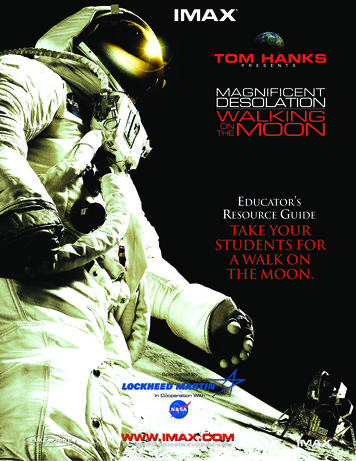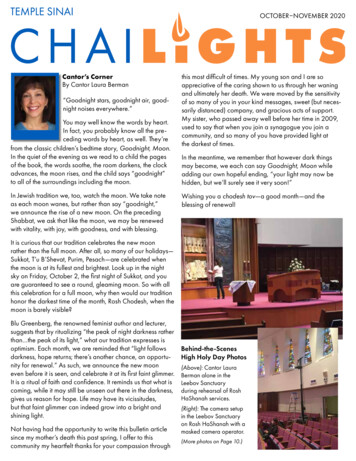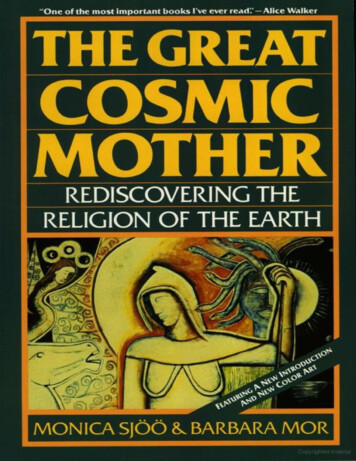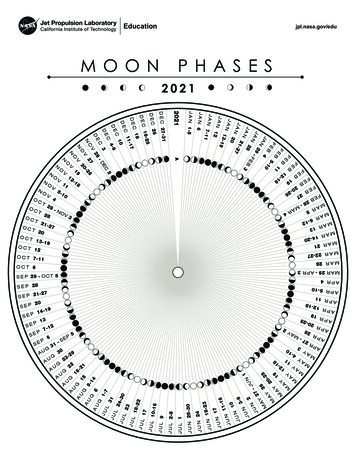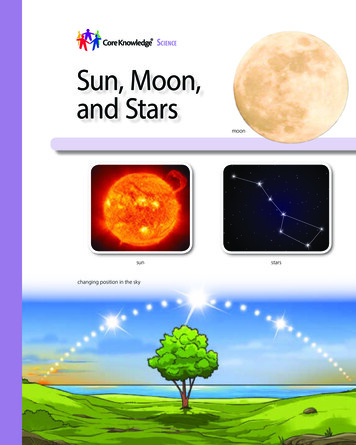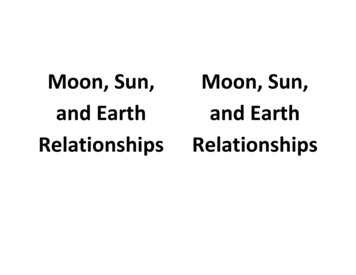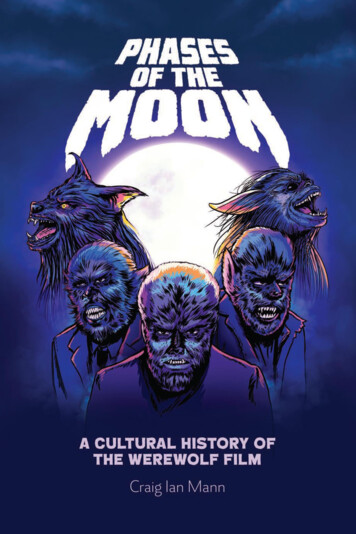
Transcription
Phases of the Moon6535 MANN.indd i14/09/20 11:51 AM
6535 MANN.indd ii14/09/20 11:51 AM
Phases of the MoonA Cultural History of theWerewolf FilmCraig Ian Mann6535 MANN.indd iii14/09/20 11:51 AM
For the Monster SquadEdinburgh University Press is one of the leading university presses in the UK.We publish academic books and journals in our selected subject areas across thehumanities and social sciences, combining cutting-edge scholarship with high editorialand production values to produce academic works of lasting importance. For moreinformation visit our website: edinburghuniversitypress.com Craig Ian Mann, 2020 Foreword, Stacey Abbott, 2020Edinburgh University Press LtdThe Tun – Holyrood Road12 (2f) Jackson’s EntryEdinburgh EH8 8PJTypeset in Monotype Ehrhardt byIDSUK (DataConnection) Ltd, andprinted and bound in Great BritainA CIP record for this book is available from the British LibraryISBN 978 1 4744 4111 7 (hardback)ISBN 978 1 4744 4113 1 (webready PDF)ISBN 978 1 4744 4114 8 (epub)The right of Craig Ian Mann to be identified as author of this work has been asserted inaccordance with the Copyright, Designs and Patents Act 1988 and the Copyright andRelated Rights Regulations 2003 (SI No. 2498).Every effort has been made to trace the copyright holders for the images that appear inthis book, but if any have been inadvertently overlooked, the publisher will bepleased to make the necessary arrangements at the first opportunity.Cover image by Mute: www.mutecult.com6535 MANN.indd iv14/09/20 11:51 AM
ContentsList of FiguresAcknowledgementsForeword: Monsters Everywhere by Stacey AbbottviviiixiIntroduction: Bark at the Moon1 Wolves at the Door2 Dogs of War3 Pack Mentality4 Hounds of Love5 What Big Teeth You Have6 The Better to Eat You With7 Old Dogs and New Tricks8 ShapeshiftersConclusion: Who’s Afraid of the Big Bad Wolf 2362476535 MANN.indd v14/09/20 11:51 AM
Figures1.1 A still from the lost film The Werewolf (1913), originallypublished in Universal Weekly, in which the she-wolfWatuma is confronted by men of God1.2 The villainous Dr Yogami, as portrayed by Warner Olandin Werewolf of London (1935), functions as a xenophobicembodiment of the ‘yellow peril’1.3 The Wolf Man shows his heroism as he prepares to dobattle with Frankenstein’s creature at the climax ofFrankenstein Meets the Wolf Man (1943)2.1 Phyllis Allenby fearfully reads up on werewolfery inShe-Wolf of London (1946), before discovering she isnot suffering from the ‘Allenby Curse’ at all2.2 A lobby card produced to promote The Mad Monster (1942),illustrating the power that Dr Cameron holds over Petro,his test subject2.3 The atomic mutant as imagined by The Werewolf (1956),in which Duncan Marsh becomes a monster after he isinjected with irradiated wolf ’s blood3.1 The Devil’s Advocates meet a group of satanic monks inWerewolves on Wheels (1971), creating a striking visualcontrast between the bikers and the devil-worshippers3.2 In The Boy Who Cried Werewolf (1973), monsters attacktheir families; here Robert Bridgestone looms over hissleeping wife, Sandy3.3 An American theatrical poster for The Werewolf ofWashington (1973), featuring an image and tagline thatboth belie its obvious political commentary4.1 The Curse of the Werewolf (1961) features a beggar whotakes on the characteristics of a wolf after years ofimprisonment4.2 An original Italian poster designed to promote Lycanthropus(1961), which clearly plays on the film’s preoccupationwith sexual violence6535 MANN.indd vi152234505560737781909814/09/20 11:51 AM
FIGURES4.3 At the opening of Werewolf Woman (1976), Danielaexperiences a vision of her ancestor, who celebrates hersexuality before transforming into a she-wolf5.1 The monstrous ‘new werewolf ’ as it appears in The Howling(1981) – a distinct departure from the wolf-men that haddominated the werewolf film since the 1930s5.2 David Kessler experiences extreme pain and suffering as hetransforms in An American Werewolf in London (1981)5.3 In Howling II: Your Sister is a Werewolf (1985), werewolferyis associated with sexual deviancy; here, Stirba has groupsex with two of her followers6.1 A poster for Silver Bullet (1985), depicting thebaseball bat that functions as a recurring metaphorthroughout the film6.2 During a dream sequence in Silver Bullet (1985), thecitizens of Tarker’s Mills transform into werewolvesduring a funeral in an indictment of conservative values6.3 In a satirical comment on Reaganite masculinity, ‘The Wolf ’ –portrayed here by Michael J. Fox in Teen Wolf (1985) –resembles a caveman as much as a wolf-man7.1 The special make-up effects worn by Jack Nicholson inWolf (1994) were designed by Rick Baker to recall theclassic wolf-men of the 1930s and 1940s7.2 Having chosen to embrace his werewolfism, Will Randallfully and irreversibly transforms from human to lupineform at the conclusion of Wolf (1994)7.3 The werewolf cops central to Full Eclipse (1993) are designedto recall comic book superheroes such as the X-Men7.4 In Ginger Snaps (2000), the eponymous Ginger Fitzgeraldbecomes increasingly monstrous as her behaviour spiralsout of control8.1 When Animals Dream (2014) opens as Marie is enduring aninvasive examination by Dr Larsen, establishing her distastefor being objectified8.2 In WolfCop (2014), vigilante werewolf Lou Garou fightscrime in his uniform even when transformed, but ultimatelydoes not represent the establishment8.3 In Howl (2015), werewolves slowly transform into monstersover a prolonged period of time, giving them a distinctlyhuman appearance6535 MANN.indd /09/20 11:51 AM
AcknowledgementsOne dark afternoon in the 1990s (when I was nine or ten years old),a friend invited me to his house to watch horror films, having convincedhis parents to buy a VHS box set containing Bram Stoker’s Dracula (1992),Mary Shelley’s Frankenstein (1994) and Wolf (1994). We watched thelatter, in which Jack Nicholson turns feral and urinates on James Spader’sshoes. I borrowed the tape and didn’t give it back for a decade. In the following years, I watched as many werewolf films as I could. So my firstthanks go to Ryan Watson – who sussed the fine art of convincing hisparents to buy horror films for him at an impressively young age.The seed of this book was planted in my undergraduate dissertation,written at Sheffield Hallam University in 2010, which was inspired inequal part by a lifelong love of werewolf fiction and Shelley O’Brien’smodule on the American horror film. I’m grateful to Shelley for thinking that writing about werewolf films was a good idea in the first placeand her supervision of both that dissertation and the thesis that formedthe basis of this book. A huge thank you is due to the director of my doctoral studies, Sheldon Hall, who has continually challenged me to makemy work better; constantly encouraged me in furthering my professionaldevelopment; provided many obscure films; answered my tiresome andoften inane questions at all hours of the day and night (I’m not actuallysure when it is that he sleeps); read first (and sometimes second . . . andthird . . . ) drafts of almost everything I have ever written; and offered aspellchecking service that money couldn’t buy. I also owe a great deal ofgratitude to Gillian Leslie and Richard Strachan at Edinburgh UniversityPress for all their help, guidance and, perhaps most importantly, patience.Writing this monograph would have been considerably more difficultwithout the help and support of several individuals who have providedmaterial that would otherwise have been difficult to obtain: thanks toAngela Quinton of Werewolf-News.com for maintaining an incrediblyuseful website; to the late Peter Hutchings – a giant in horror studies –for providing his contribution to the collection She-Wolf (2015), and to6535 MANN.indd viii14/09/20 11:51 AM
AC K N OW L E D G E M E N T Sixthe editor, Hannah Priest, for several other chapters; to Lowell Dean forgranting early access to WolfCop (2014); to Simon Brown for providinghis conference paper on Silver Bullet (1985) and his endless kindness; toKieran Foster for digitising The Werewolves of Moravia; to Stacey Abbott,Chi-Yun Shin and Iain Robert Smith for their vital examiners’ commentson my thesis; a second thanks to Stacey for graciously agreeing to pen aforeword to this book; and a huge thank you to Dave Huntley for producing some jaw-dropping cover art. Thanks are also due to others whohave offered so many forms of help and encouragement along the way:Sergio Angelini, Liam Ball, Kev Bickerdike, James Blackford, Jon Bridle,Louise Buckler, Jake Burton, Leah Byatt, Andy Cliff, Chris Cooke, JonDickinson, Liz Dixon, Larry Fessenden, Liam Hathaway, Chris and LisaHopkins, Dawn Keetley, Murray Leeder, Kurt McCoy, Mike Mann, JoeOndrak, Jon Robertson, Caitlin Shaw, Suzanne Speidel, Eric J. Stolze,Chris Suter and Johnny Walker. Special thanks are due to Stella Gaynor,Shellie McMurdo, Laura Mee and Tom Watson; they know why.I can’t offer enough thanks to my mother, Gillian Mann, who has alwayssupported me and has made untold sacrifices with no (well, very few)complaints; did everything she could to fuel my love for movies from avery young age; and even encouraged my passion for horror films – unlessit was The Exorcist (1973), which was for many years kept in an ominousblack box on the top shelf of the video cabinet. Finally, thank you to RoseButler, who was the primary sounding board for the majority of ideas inthis monograph, for listening to me complain during frustrating spellsof writer’s block, watching a great many films of somewhat questionable quality and spending several years silently tolerating my tendency toturn nocturnal during writing periods (along with a number of other badhabits). I hope you found what you were hunting for.*An earlier version of Chapter 3 was previously published in ‘Horror Studies’10.1 (2019).A section of Chapter 5 was previously published with Arrow Video’s2019 release of An American Werewolf in London (1981).6535 MANN.indd ix14/09/20 11:51 AM
6535 MANN.indd x14/09/20 11:51 AM
Foreword: Monsters EverywhereMonsters are everywhere and our continued fascination with them –expressed by dressing up as Dracula or Morticia on Halloween, watchingDanny Boyle’s stage adaptation of Frankenstein (2011), or indulging thecarnivalesque pleasure of a zombie walk – shows that monsters continueto have cultural value; to have meaning. They speak to our fears and ourdesires. They embody our past and our future. They express our psycheand our politics but that meaning, like the monster that embodies it, isnot fixed. Together they shift and change, responding to a plethora ofinfluences and contexts. Drew Barrymore’s twenty-first-century liberatedzombie of Netflix’s serialised sit-com Santa Clarita Diet (2017–) has littlein common with the mind-controlled zombies enslaved by Bela Lugosi inthe horror film White Zombie (1932). The aristocratic vampires of Universal Studios’ Dracula (1931), Dracula’s Daughter (1936) and Son of Dracula(1943) are a world apart from the working class, damaged vampires ofMartin (1977), The Hamiltons (2006) and The Transfiguration (2016).Nina Auerbach famously opened her groundbreaking Our Vampires,Ourselves (1995) with the statement ‘we all know Dracula, or think wedo, but as this book will show, there are many Draculas – and still morevampires who refuse to be Dracula or to play him’. She argued that therewas a vampire for every generation. Her work took an interdisciplinaryapproach to consider the cultural meaning of the vampire across literature, film and television, much like Gregory A. Waller’s The Living and theUndead (1986). Others have followed similar paths in relation to a range offolkloric and literary monsters. David J. Skal’s The Monster Show: A Cultural History of Horror (1994) offers a rich overview of the history of monsters throughout popular culture, from freak shows to stage and screen togothic literature and comic books.Tanya Krzywinska examines the cinematic legacy of witchcraft andmagic in A Skin for Dancing In: Possession, Witchcraft and Voodoo in Film(2000). Kyle William Bishop’s American Zombie Gothic: The Rise and Fall6535 MANN.indd xi14/09/20 11:51 AM
xiiPHASES OF THE MOON(and Rise) of the Walking Dead in Popular Culture (2010) offers a painstaking reading of the zombie as a monster from the Americas, tracing itsevolution from Haitian folklore, a product of a history of colonialism andslavery, to post-Romero contemporary American cinema and television.Roger Luckhurst examined the cultural fascination of the myth of theMummy in The Mummy’s Curse: The True History of a Dark Fantasy(2012) and followed this with a rich global cultural history of the zombiein Zombies: A Cultural History (2015). As these books attest, monsters areindeed everywhere.When I started work on my book Celluloid Vampires: Life after Death inthe Modern World (2007), which began its life in 1997 as my doctoral thesis, I was most influenced by Waller and Auerbach’s work on the vampire.I sought to follow their lead but with a specific focus on the cinematicafterlife of the vampire. I was struck by how few scholarly works on vampires, or other monsters for that matter, focused exclusively on film. Itherefore decided to examine how developments within cinema shapedthe vampire but also how the cinematic vampire was shaped by industrial,cultural and social contexts of the twentieth century. Not a creature thatembodied the past returned to haunt the present, but a monster born ofthe modern world. With the growing popularity of vampire and zombiefilm and television in the twenty-first century, I took a similar approach inUndead Apocalypse: Vampires and Zombies in the 21st Century (2016).The werewolf, a shapeshifter by nature, is potentially even more mutable than the undead and yet has received far less scholarly consideration,despite a folkloric and cinematic history as rich as the vampire. WhileHannah Priest’s She-Wolf: A Cultural History of Female Werewolves (2015)and Samantha George and Bill Hughes’s In the Company of Wolves: Werewolves, Wolves and Wild Children (2020) offer an interdisciplinary examination of the werewolf, little attention has been paid to the history of thewerewolf in its cinematic form until Craig Ian Mann’s Phases of the Moon:A Cultural History of the Werewolf Film.As Mann so eloquently demonstrates, when Universal began making what would become their horror classics in the 1930s, the werewolfjoined the pantheon of Universal monsters, after Dracula, Frankenstein’screature, the Invisible Man and the Mummy, first in Werewolf of London(1935) and then to even greater success with The Wolf Man (1941). WhileWerewolf of London offered a stunning transformation sequence that signalled the genre’s close affinity with cutting-edge special effects, it wasLon Chaney Jr’s incarnation of the cursed Larry Talbot in The Wolf Manthat became as iconic to the werewolf myth as Lugosi was for Draculaand Karloff for Frankenstein’s creation. The werewolf is in many ways6535 MANN.indd xii14/09/20 11:51 AM
FOREWORDxiiione of the most brutal of monsters and yet, following Chaney’s lead, theyoften evoke the greatest sympathy, presented as being as much a victim asa monster.But, like the vampire, there is not one werewolf but many werewolves –and these early successes for Universal opened the door to a century’sworth of re-imaginings of the monster. Some werewolves are cuddly andcomic, like Michael J. Fox’s Teen Wolf (1985), while others are virile andhyper-masculine, like Jack Nicholson’s Wolf (1994); some invite sympathy and identification, such as David Kessler in An American Werewolfin London (1981), while others still, like the pack in Dog Soldiers (2002),are unknowable. There are werewolves for every generation, speaking toa diverse and complex range of social, cultural, political and industrialhistories that shaped and moulded this shapeshifter into new forms andnew narratives. It is to these histories of the cinematic werewolf that Mannturns, offering a rich and comprehensive analysis of the werewolf moviefrom the first cinematic forays into the genre with The Werewolf (1913)and The White Wolf (1914) to twenty-first-century horror films such asLate Phases (2014) and Wildling (2018).Mann’s discussion of 100 years of cinema deliberately moves beyond theperception of the werewolf as representing the beast within to show howthis shapeshifter has transformed with the times, articulating, embodyingand responding to, sometimes contradictory, socio-cultural and politicalhistories. Written with a passion for the genre alongside a historian’s keeneye for cultural meanings, Phases of the Moon shows us how the cinematicwerewolf, like so many monsters, has much to tell us about ourselves, ourpast and our present. Filled with insight and encyclopaedic knowledgeof all things lycanthropic, Mann gives the reader plenty to chew over. Sitback and enjoy. It’s time to howl at the moon.Stacey Abbott6535 MANN.indd xiii14/09/20 11:51 AM
6535 MANN.indd xiv14/09/20 11:51 AM
Introduction: Bark at the MoonA full moon looms over a dark forest in the blackest night and, somewheredeep amongst the overgrown trees, something howls.It is a scene as familiar as that of a vampire lurking deep in the catacombsof a Transylvanian fortress; as ingrained in popular culture as the image ofa patchwork monster rising from the dead amongst crackles of electricity;as enduring as a Pharaoh escaping his sarcophagus to take revenge on thosewho have disturbed thousands of years of peaceful rest. Such a story instantlybrings to mind the image of a werewolf, a mainstay of horror fiction that hasbecome synonymous with a feral beast, savage and uncontrollable.A basic definition for the mythical creature termed a werewolf is ahuman being who, either purposely or against their will, transforms intoa wolf. Certain accounts depict a partial transformation into a monstroushybrid of human and lupine features while others depict a complete anatomical transition from human to wolf. Outside of this basic definition,fictional depictions of werewolves often adapt existing mythology, established by other werewolf tales in several media, or create their own. Thecircumstances of transformation, the effect this transformation has on theindividual, how much humanity remains once transformation is completeand whether the condition can be considered a blessing or a curse are allnarrative elements that have changed frequently. And there are multiplenames for such a monster: werewolf, wolf-man, shapeshifter, skinwalkerand lycanthrope are the most common in the English language. However,even with so many variations of the myth in existence, the basic concept ofthe werewolf itself remains deeply ingrained in popular culture, especiallyin Europe – where the fear of werewolves reached its peak during the EarlyModern period – and nations historically colonised by European peoples.This study is dedicated to the werewolf in cinema, with a particularemphasis on that genre that has become so synonymous with tales ofwerewolfism: horror. From The Wolf Man (1941) to WolfCop (2014) viaI Was a Teenage Werewolf (1957), Werewolves on Wheels (1971) and AnAmerican Werewolf in London (1981), it presents a history of the werewolf6535 MANN.indd 114/09/20 11:51 AM
2PHASES OF THE MOONfilm from its origins in the silent era to contemporary examples. In doingso, it explores the monster’s cultural significance, making the case for itas a product of its times: a mutating metaphor that can be seen to shiftand evolve in tandem with the fears and anxieties particular to its historical moment. This, of course, is not an unusual approach to monsters incinema, but it is a significant departure from existing academic work onthe werewolf film.For scholars, the werewolf has long been associated with the ‘beastwithin’. Since the nineteenth century, the monster has come to beclosely associated with this concept, and the phrase is still employedwidely in academic responses to werewolf fiction. It is designed, ofcourse, to emphasise the psychological dimension of ‘werewolfism’ or‘werewolfery’ – or ‘lycanthropy’, a term that is itself problematic due toits clinical connotations – and to suggest that the affliction is symptomatic of a war between the civil and bestial sides of the human self. It isnow often used as a universal explanation for the enduring appeal of thewerewolf across several media and even the sole source of its thematicsignificance. As Anne Billson argues in a discussion of contemporarywerewolf films, ‘Werewolves may seem less versatile in metaphoricalterms than vampires or zombies, which these days can symbolise justabout anything . . . The werewolf, on the other hand, is basically justthe beast within.’1Historically, Billson has not been alone in this view. The werewolf, especially in cinema, has not been widely studied; however, a considerable proportion of the existing writing on the subject uses psychoanalysis as a frameworkthrough which to form its conclusions. For example, Reynold Humphriessuggests that Werewolf of London (1935) is an allegory for castration anxiety,2 and that The Wolf Man (1941) uses its protagonist’s monthly transformations as a metaphor for menstruation, leading to a climax in which ‘Thefather kills the son for not being man enough, according to the dominantvalues he represents.’3 Meanwhile, James B. Twitchell argues that the werewolf myth is a precursor to the themes of duality and sexual violence raisedby Robert Louis Stevenson’s Strange Case of Dr Jekyll and Mr Hyde (1886).He argues that the werewolf is best understood as ‘a skin changer, a paganturncoat who did for generations of Europeans what Mr Hyde does for us: heprovided first the frisson of a metamorphosis gone awry, and then the shockof ensuing bestial aggression’.4Similarly, in The Curse of the Werewolf: Fantasy, Horror and the BeastWithin (2006), Chantal Bourgault du Coudray posits that the werewolffilm generally articulates a deep-seated fear of the beast within by figuring werewolfism as symptomatic of repressed masculine aggression. She6535 MANN.indd 214/09/20 11:51 AM
I N T RO D U C T I O N3argues, for example, that The Wolf Man ‘consolidated the werewolf of thecinema as psychologized and masculine’ and ‘explores the consequencesof a failure to “discipline” the “beast within” for male power and identity’;5 suggests The Werewolf of Washington (1973) delivers an ‘unequivocal’ message that ‘normative masculinity is vulnerable to the onset ofsudden crisis’;6 and asserts that the infamous transformation scene in TheHowling (1981) emphasises ‘the masculinity of the werewolf ’s body’.7The allure of using psychoanalysis to explain the enduring popularityof the werewolf is not difficult to comprehend. The words ‘lycanthrope’and ‘lycanthropy’ are clinical terms, and psychosis leading human beingsto believe they have the ability to transform from human to lupine formhas been considered a disease of the mind for thousands of years.8 Earlywerewolf films actively play on the monster’s psychological dimensions;the silent Wolfblood (1925), for example, never reveals whether its apparent werewolf is a literal monster or simply a broken man who is sufferingfrom terrible delusions. It concerns Dick Bannister (George Chesebro),the manager of a logging company who receives a blood transfusion from awolf after a serious accident in the Canadian wilderness. Following a spateof wolf attacks around his camp, Bannister comes to believe he is a werewolf. By the film’s end it is heavily implied that he is simply delusional:a lycanthrope rather than a werewolf. Similarly, The Wolf Man devotesmuch of its running time to exploring the inner turmoil of its werewolfprotagonist as he tries to discern if he is a wolf-man or a madman.It might seem that these are themes that have always been at the heart ofwerewolf fiction – and, if that were true, it would certainly explain the dominance of psychoanalysis in studies of the werewolf in cinema. But in factthe idea of the ‘beast within’ developed only in the 1800s, while the werewolf myth itself is thousands of years old. As Leslie A. Sconduto explainsin her monograph Metamorphoses of the Werewolf: A Literary Study fromAntiquity through the Renaissance (2008), the earliest reference to a werewolfin ancient literature is in fact ‘in the Akkadian Epic of Gilgamesh, a collection of mythic tales which circulated in the region of southern Mesopotamia’.9 Thereafter, werewolves appear in Ovid’s Metamorphoses, authoredin AD 8, and Petronius’s The Satyricon, which was circulated during thereign of Nero. In the centuries following these initial accounts, the werewolf myth proliferated throughout Europe.With the fall of the Roman Empire and the coming of Christianity, theChurch was forced to reconcile a popular belief in creatures such as werewolves with religious doctrine. As Sconduto notes, ‘seen as remnants ofpagan beliefs and practices, the werewolf legends inherited from antiquitythreatened Christian notions of divinity, creation and salvation’.10 Sconduto6535 MANN.indd 314/09/20 11:51 AM
4PHASES OF THE MOONasserts that Christian writers found it important to re-evaluate the mythsinherited from antiquity in an attempt to deny the existence of werewolves orotherwise propose that the appearance of metamorphosis could be achievedonly through demonic trickery.11 In short, early clerical writings stressedthat the idea of a man transforming into an animal was either impossible orillusionary.However, the efforts of clerics to quell a popular belief in werewolvesfailed, and the werewolf thereafter became a prominent figure in medievalliterature. To illustrate changing attitudes to the monster, Sconduto highlights several texts from the twelfth and thirteenth centuries in which menare transformed into wolves as punishment for their sins. The werewolvesin these tales retain their human minds and souls, forced to roam the earthas wolves in atonement.12 In a further attempt by clerical writers to rationalise metamorphosis in the context of Christianity, then, these tales suggested ‘God is using metamorphosis to carry out his divine vengeance . . .to make visible his authority over mankind’.13 Such stories were likelyinspired by a similar account of metamorphosis included in the Bible, inwhich God turns the Babylonian king Nebuchadnezzar into an animal inorder to punish him.14 Thereafter, medieval writings would come to featuresympathetic, noble and sometimes tragic werewolves who play a part in narratives designed to deliver a Christian message, often condemning a sin orendorsing a virtue; for a time, the werewolf became the hero of its narrative.For example, Sconduto argues that Marie de France’s Bisclavret – writtensometime between 1160 and 1178 – is a lesson on the importance of loyalty.15Sconduto goes on to analyse three other medieval texts in detail, outlininghow they condemn cardinal sins such as pride and lust or endorse Christiannotions of virtue, such as personal sacrifice.16 What is common amongstthese medieval tales is that the werewolf comes to embody Christian values,while his antagonist is often a wicked woman who seeks to betray or outwithim. In many ways, then, these stories reinforce not just Christian doctrinebut the Church’s patriarchal control.The depiction of werewolves radically changed during the EarlyModern period, as Europe was gripped by a widespread fear of witchcraft and the supernatural. As Brian P. Levack attests: ‘roughly from1450 to 1750, thousands of persons, most of them women, were triedfor the crime of witchcraft. About half of these individuals were executed, usually by burning.’17 Perhaps the first writing that documentsa change in the Church’s position on the occult is the Malleus Maleficarum – or The Hammer of Witches – originally penned by HeinrichKramer in 1486. The text directly contradicts the clerical writings thatfollowed the decline of the Western Roman Empire: ‘instead of stating6535 MANN.indd 414/09/20 11:51 AM
I N T RO D U C T I O N5that it is blasphemous to believe in the existence of witches and theirability to fly and transform themselves, he declares that witches reallyexist and that it is heretical to believe the opposite’.18 It is probablethat the Malleus Maleficarum, like many medieval werewolf stories, wasintended to reinforce Christian patriarchy; its focus is almost entirelyon female witches and it has since been noted by scholars that it is afundamentally misogynistic text which aided heavily in the oppressionof women.19 However, a patriarchal subtext is perhaps the only thingthat the Malleus Maleficarum has in common with earlier werewolfwritings of the Middle Ages; for the most part it can be seen to serve asa counterpoint to the idea of the werewolf as noble victim.Designed to aid inquisitors and to serve as a theological basis for heresytrials, Kramer’s text took hold in Europe and helped to develop a widespread belief in satanism and black magic. Of course, this also had implications for the Church’s stance on metamorphosis and werewolfery: ‘inaddition to affecting attitudes regarding witchcraft, the text shaped opinion about werewolves, for belief in witches and their ability to transformthemselves into animals also made the belief in werewolves permissible’.20As the witch-hunt began, the noble medieval werewolf was replaced by ‘arough, dirty peasant who savagely attacks, kills, and then eats his victims,who are usually children’.21Furthermore, these werewolves were not confined to the pages of literature. They were, to an extent, real: court records detail the trials of individuals who were accused of werewolfism during the witch-hunt. For example,Peter Stumpp – or the ‘Werewolf of Bedburg’ – was a
battle with Frankenstein's creature at the climax of Frankenstein Meets the Wolf Man (1943) 34 2.1 Phyllis Allenby fearfully reads up on werewolfery in She-Wolf of London (1946), before discovering she is not suffering from the 'Allenby Curse' at all 50 2.2 A lobby card produced to promote The Mad Monster (1942),


